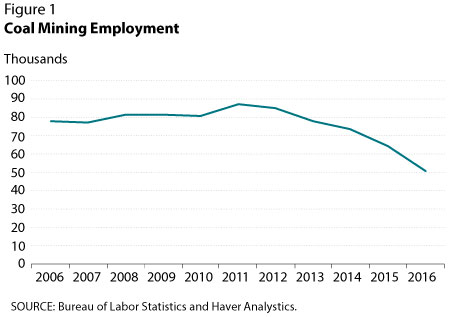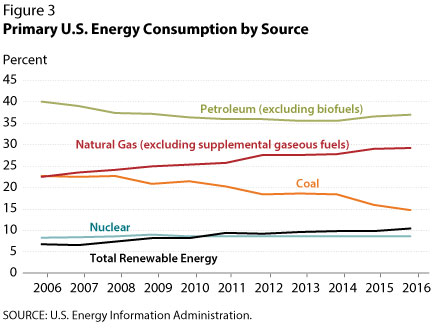The Decline of Coal
Recently, attention has focused on the plight of U.S. coal workers after a difficult decade for the coal industry. Depressed global demand for coal has driven down its price, affecting profits for producers. Coal miners, in particular, have been hurt over the past decade, as employment has fallen 42 percent from its high in 2011 (Figure 1). Some have attributed coal's misfortune to increased regulation on carbon emissions. Although regulation increases costs for coal producers, coal's main problem is technology that has reduced the cost of competing sources of energy.


Natural gas prices have fluctuated between $2 and $4 per MMBtu during the past three years and are currently 77 percent below their June 2008 peak of nearly $13 per MMBtu (Figure 2).1 These low prices have shifted energy consumption away from coal to natural gas.

Figure 3 shows U.S. energy consumption over the past 10 years. In that time, natural gas has replaced coal: Coal and natural gas consumption were each around 22 percent of consumption in 2006, but coal consumption declined to 15 percent while natural gas increased to 29 percent by 2016. Renewable energy has also flourished, rising from about 7 percent to 10 percent of consumption, while nuclear power consumption has remained flat. Petroleum remains the largest single source of energy, with consumption just under 40 percent. Nearly half of petroleum is consumed as motor gasoline, while about one-fifth is used for diesel and heating oil.2
The decline in natural gas prices has not affected the ability of natural gas firms to stay in business. Several factors have helped. Key among them is that better tools and technology have allowed more-complex wells with better technology to be completed. Despite being more expensive to drill, these wells have increased productivity and efficiency, lowering the market price. These efficiency gains have allowed natural gas to remain profitable and have done little to deter production.3
It is likely that production of natural gas will at least remain steady for the near future; respondents to the Dallas Fed Energy Survey predict that natural gas prices will remain low for the rest of the year.4 During the second quarter of 2017, exploration and production firm executives in that survey reported the third straight increase in quarterly production, albeit the pace of the increase had slowed. Since 2015, U.S. natural gas production has been around 90 billion cubic feet per day, and extraction of natural gas has increased 40 percent since 2006. It appears that natural gas (as well as renewables) will continue to displace coal in energy consumption.
Notes
1 MMBtu stands for one million British thermal units (BTU). A BTU is a measure of the energy content in fuel.
2 See U.S. Energy Information Administration. "Oil: Crude and Petroleum Products Explained." November 28, 2016, update; https://www.eia.gov/energyexplained/index.cfm?page=oil_use.
3 See U.S. Energy Information Administration. "Trends in U.S. Oil and Natural Gas Upstream Costs." March 23, 2016; https://www.eia.gov/analysis/studies/drilling/.
4 See Dallas Fed Energy Survey. "Oil and Gas Expansion Continues but Uncertainty Rises." Second Quarter, June 28, 2017; https://www.dallasfed.org/research/surveys/des/2017/1702.aspx.
© 2017, Federal Reserve Bank of St. Louis. The views expressed are those of the author(s) and do not necessarily reflect official positions of the Federal Reserve Bank of St. Louis or the Federal Reserve System.


 follow @stlouisfed
follow @stlouisfed